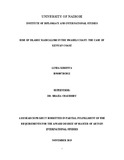| dc.description.abstract | The world is currently experiencing the threat of radical Islam with daunting challenges to
governments and policy makers on how to manage the threat. East Africa and particularly the
Swahili coast has been home to Islam religion since the 1900s, where followers have practiced the
moderate Sufi form of Islam. The past two decades have however witnessed the infiltration of
radical forms of Islam in the region. Furthermore, in the post 9/11 conditions and especially with
the global war on terror, evidence of Islamic militancy in the region has caused the international
community to regard the region as a ‘hotbed of terrorism’. Despite the growth of radical political
activism in the Swahili coast, available research has failed to examine the factors that contribute
towards its rise. Historically, Islam has played a significant role in Swahili coast’s politics and is
often drawn upon to provide basis to argue for political and social reforms in a region that perceives
itself as largely marginalized by the successive Kenyan Christian governments. Irrespective of
their grievances and goals, radical Islamist groups are causing great concern to the government as
they cause political instability, they disrupt social harmony, they hamper economic development,
endanger regime survival and most of all threaten national security in their wake. Direct economic
costs as a result of the security threat in the country include the destruction and degradation of
physical capital and infrastructure, lost employment opportunities, and capital flight. Indirect costs
include weakened institutions and a fragmented social fabric. This study therefore seeks to
examine and understand the factors that contribute to the rise of Islamic radicalism in the target
region, It seeks to examine the ideological conditions that facilitate the growth of radical Islamism
in the Swahili coast; the internal and external factors that facilitate the rise of radical Islamism at
the Kenyan Swahili coast; and examine the threats of terrorism to Kenya. Understanding the
motivating factors for Islamic radicalism can help governments and policy makers devise
appropriate response mechanisms to alleviate the problem. The study was restricted to the Coastal
region of Kenya where the researcher collected both secondary data from published materials,
journals, academic papers and periodicals on Islamic activities at the Swahili coast and primary
qualitative data through semi-structured interviews. The researcher used snowball and purposive
sampling approach where the researcher requested a few interviewees to recommend other people
to be interviewed that they already know and that have a higher chance of adding value to the
research study. This method relies on the interviewee’s understanding and general knowledge of
area of study, their availability, and their desire to participate in the entire study.1 The findings
supports the root cause model that radicalization arises from external level factors, internal social
causes, and individual level factors which have a direct interaction with the level of political
socialization of individuals. The study concludes that the government must devise other nonmilitaristic
counter-terrorism/radicalism policies and efforts mostly focused on de-radicalization
initiatives, socio-economic reintegration of radical elements, and most importantly entrenching
inclusive governance that caters to the needs of all Kenyan citizens. | en_US |

